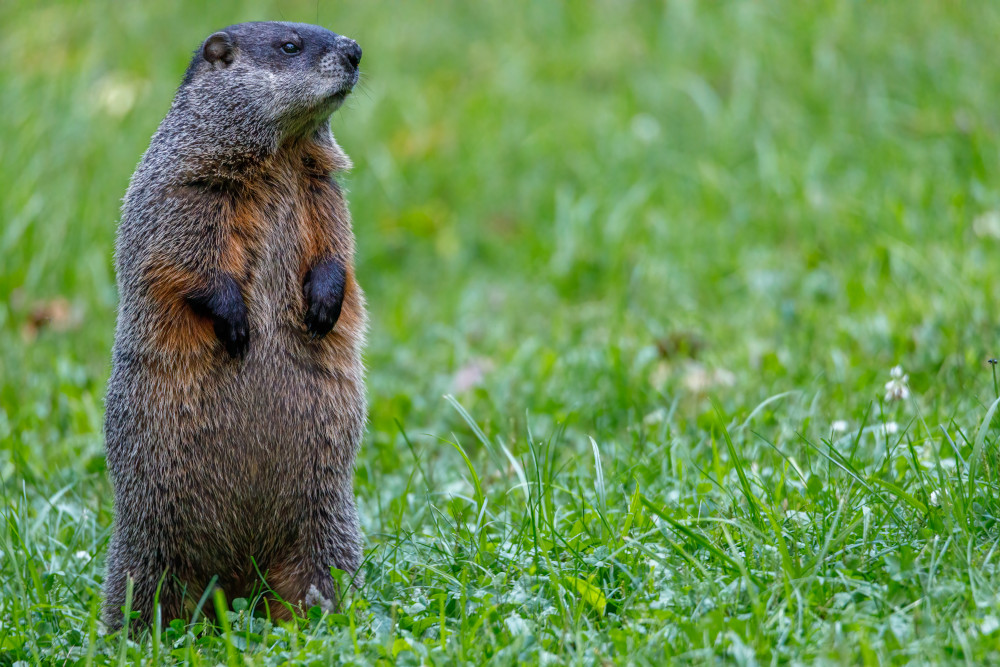Lakehead University research study finds groundhog predictions should not be trusted

Groundhog photo from Pexels.com.
January 31, 2022 – Thunder Bay, Ont.
Are you looking to the groundhog this year to tell you when spring will arrive?
If so, a Lakehead University professor may have some bad news for you. Dr. Michael Rennie and his students recently studied the accuracy of Groundhog Day predictions and determined that flipping a coin does as good a job as predicting the arrival of spring as these furry rodents.
Rennie leads the Community Ecology and Energetics lab that published the study in “Weather, Climate and Society,” last year.
Rennie, Canada Research Chair in Freshwater and Fisheries and Associate Professor in Biology, and his graduate students gathered all the data they could find from North American groundhogs, spanning 33 locations and over 530 groundhog ‘observations.’
According to the paper, this is by far the most comprehensive evaluation of groundhog-based spring predictions to date.
He and his students examined Groundhog Day predictions from as far south as General Beauregard Lee in Georgia to Winnipeg Willow in Manitoba – spanning more than 15 degrees latitude and going back several decades, with one set of predictions from as far back as a century ago.
This became a lab project that they worked on and off over several years, resulting in the published research.
“More than anything, this was also a good exercise – especially for the more junior students to appreciate how a collaborative research project works and the trials and tribulations of publication,” Rennie said.
“Even though we are all often working on our own projects, it’s great to work together on a common question and see it through to the end.”
In the end, the researchers found that, across all groundhogs, the onset of spring was predicted correctly exactly 50 per cent of the time – the same outcome you would expect from flipping a coin, which did not surprise Rennie.
“If you think about it, we celebrate Groundhog Day a full month before these animals typically emerge from hibernation, so this practice is completely disassociated from any meaningful biological response that groundhogs might otherwise have for detecting spring conditions” he said.
Many people often wait for Groundhog Day, set on February 2, with some anticipation, particularly in North America where much of the continent is still in the throes of winter and many residents are looking forward to warmer weather.
As the legend goes, if the groundhog sees its shadow it will return to its burrow and spring will arrive late. If it does not see its shadow, everyone rejoices at the prospect of an early spring.
The researchers faced some challenges when examining Groundhog Day predictions. Because spring comes at different times for each of these groundhogs, the group needed to determine objectively if spring arrived early or late at each location in any given year.
For this determination, they turned to a spring blooming flower, the Carolina Spring Beauty, distributed equally to all areas where groundhogs made their predictions. In another recent publication, work from Rennie’s lab determined that this flower would bloom predictably after accumulating a certain amount of thermal energy, known as “degree days.”
The researchers then used data from weather stations near each groundhog’s location to estimate this bloom date – and thus the arrival of spring in that location each year. Then it was simply a matter of determining how well each groundhog’s prediction of ‘early’ or ‘late’ matched with the actual arrival of spring.
Some groundhogs could be given a passing grade for their predictive prowess – with Essex Ed (Essex, Connecticut), Stonewall Jackson (Wantage, New Jersey), and Chuckles (Manchester, Connecticut) predicting spring onset more than 70 per cent of the time, but no single groundhog made predictions with any level of accuracy worth relying on.
“We did, however, have a friendly bet going as to whether the Canadian groundhogs did any better than American ones. They did not,” Rennie said, adding that it appears one of the groundhogs may believe in climate change.
“Probably the most surprising result was that one of the longest prognosticating groundhogs, Punxsutawney Phil, seems to be a proponent of climate change,” Rennie said.
“In the later part of his over 100-year dataset of predictions, Phil tends to have a statistically significant propensity to predict early springs in the most recent years. Maybe he’s trying to get through to the folks who don’t seem to want to listen to climate scientists.”
– 30 –
Media: For more information or interviews, please contact Brandon Walker, Media, Communications and Marketing Associate, at (807) 343-8110 ext. 8372 or mediarelations@lakeheadu.ca.
Lakehead University is a fully comprehensive university with approximately 9,700 full-time equivalent students and over 2,000 faculty and staff at two campuses in Orillia and Thunder Bay, Ontario. Lakehead has 10 faculties, including Business Administration, Education, Engineering, Graduate Studies, Health & Behavioural Sciences, Law, Natural Resources Management, the Northern Ontario School of Medicine, Science & Environmental Studies, and Social Sciences & Humanities. Lakehead University’s achievements have been recognized nationally and internationally, including being ranked, once again, among Canada’s Top 10 primarily undergraduate universities in Maclean’s 2021 University Rankings; as well as included in the top half of Times Higher Education's 2022 World Universities Rankings for the third consecutive year, and in the top 100 of 1,115 universities from around the world in THE's 2021 Impact Rankings (which assesses institutions against the United Nations’ 17 Sustainable Development Goals). Visit www.lakeheadu.ca.

